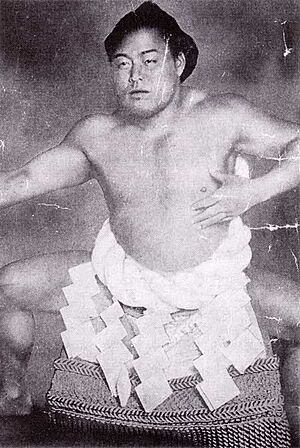Tochigiyama Moriya facts for kids
Quick facts for kids Tochigiyama Moriya |
|
|---|---|
| 栃木山 守也 | |

Tochigiyama, circa 1919
|
|
| Personal information | |
| Born | Yokoda Moriya February 2, 1892 Akama (now part of Tochigi), Tochigi, Japan |
| Died | October 3, 1959 (aged 67) |
| Height | 1.72 m (5 ft 7+1⁄2 in) |
| Weight | 104 kg (229 lb; 16.4 st) |
| Career | |
| Stable | Dewanoumi |
| Record | 197-26-24 7draws-5holds (Total) 166-23-24 7draws-4holds (Makuuchi) |
| Debut | February, 1911 |
| Highest rank | Yokozuna (February, 1918) |
| Retired | May, 1925 |
| Elder name | Kasugano |
| Championships | 9 (Makuuchi) 1 (Makushita) |
| * Up to date as of June 2020. | |
Tochigiyama Moriya (Japanese: 栃木山 守也, February 2, 1892 – October 3, 1959) was a famous Japanese professional sumo wrestler. He became the 27th yokozuna, which is the highest rank in sumo, and held this title from 1918 to 1925. Many people see him as one of the people who helped shape modern sumo. He is also known for being the lightest yokozuna ever, weighing only 104 kilograms (about 229 pounds).
Contents
Early Career: How Tochigiyama Started Sumo
Tochigiyama was born Yokoda Moriya, but he later changed his family name to Nakata. He began his sumo journey in February 1911. At first, he used the wrestling name (shikona) Tochigiyama Senjō, but he changed it to Moriya in January 1914.
His coach, Hitachiyama Taniemon, didn't expect him to be very strong because he was so light. However, Tochigiyama proved them wrong! He lost only three matches on his way up to the top division, called makuuchi, which he reached in January 1915. A big moment in his early career was when he defeated Tachiyama Mineemon in May 1916. This win ended Tachiyama's amazing streak of 56 victories!
Tochigiyama was promoted to ōzeki (the rank just below yokozuna) in May 1917. He won his first two championships as ōzeki without losing a single match. Because of these impressive wins, he was promoted to yokozuna in February 1918.
Tochigiyama as a Yokozuna Champion
Tochigiyama continued his winning streak, earning his third championship in his very first tournament as a yokozuna. He then won the next two tournaments as well. This meant he achieved an incredible five championships in a row between May 1917 and May 1919!
Tochigiyama was known for his powerful oshi, which means pushing techniques. Even though he wasn't heavy, he made up for it by training incredibly hard. People nicknamed him the "little giant yokozuna" because of his strength despite his size. Like his coach Hitachiyama, he helped train many other wrestlers, including future yokozuna Tamanishiki San'emon, even if they weren't from his own sumo stable, Dewanoumi stable.
In May 1925, Tochigiyama surprised everyone by suddenly retiring. He had just won three championships in a row between January 1924 and January 1925. When asked why he retired, he said he wanted to leave the sport while he was still at his best.
A famous painter named Foujita even painted a portrait of Tochigiyama in Paris in 1926. This painting is now kept in a museum in Grenoble, France.
Tochigiyama had an amazing record. He only lost 23 times in the top makuuchi division during his whole career. As a yokozuna, he lost only eight times in seven years! His winning percentage in the top division was 87.8%. Even more impressive, his winning percentage as yokozuna was 93.5%. This is the fourth best in sumo history, after Jinmaku, Tachiyama, and Tanikaze.
Life After Sumo: Retirement and Coaching
After he retired from wrestling, Tochigiyama was allowed to leave the Dewanoumi stable. He became the eighth head coach of the Kasugano stable. He was the adopted son of the previous head coach, who was a sumo referee named Kimura Soshiro. During his time as a coach, Tochigiyama helped train another future yokozuna, Tochinishiki Kiyotaka.
In June 1931, Tochigiyama took part in a special sumo tournament called the Dai-Nippon Rikishi Senshuken (大日本角力選手権). Surprisingly, he won the championship by defeating strong wrestlers like Tamanishiki and Tenryū. Today, retired wrestlers are not allowed to compete in special sumo tournaments.
In 1952, he performed his kanreki dohyō-iri, which is a special ceremony to celebrate a former yokozuna's 60th birthday. Even in his sixties, he was still incredibly strong. There are stories that Tochigiyama could easily carry a large hibachi (a traditional Japanese brazier) that none of his younger stable members could move!
Tochigiyama passed away suddenly in 1959 while he was still in charge of Kasugano stable. Tochinishiki, the yokozuna he had trained and adopted as his son, then took over as the head coach of the stable.
See also
- Glossary of sumo terms
- Kanreki dohyō-iri
- List of past sumo wrestlers
- List of sumo tournament top division champions
- List of yokozuna

